Dance Dance Revolution (DDR) is a music video game series produced by Konami. Introduced in Japan in 1998 as part of the Bemani series, and released in North America and Europe in 1999, Dance Dance Revolution is the pioneering series of the rhythm and dance genre in video games. Players stand on a "dance platform" or stage and hit colored arrows laid out in a cross with their feet to musical and visual cues. Players are judged by how well they time their dance to the patterns presented to them and are allowed to choose more music to play to if they receive a passing score.

Bust a Groove is a rhythm game for the Sony PlayStation released in 1998. The game was developed by Metro and published by Enix in Japan, 989 Studios in North America, and Sony Computer Entertainment Europe in Europe.

Kingdom Hearts: Chain of Memories is an action role-playing video game co-developed by Square Enix and Jupiter, and published by Square Enix in collaboration with Disney Interactive in 2004 for the Game Boy Advance. The game serves as an intermediary between the two larger-scale PlayStation 2 games in the Kingdom Hearts series. It was one of the first GBA games to incorporate full motion video (FMV).
DDRMAX Dance Dance Revolution 6thMix is the 6th game in the Dance Dance Revolution series of music video games. It was released in the arcades by Konami on October 19, 2001, and for the PlayStation 2 on May 16, 2002, in Japan. 6thMix contains a total of 42 songs, all which made their first arcade appearance on this release. 11 of these songs debuted in various console releases prior to 6thMix. All arcade songs from Dance Dance Revolution to Dance Dance Revolution 5thMix were removed in 6thMix, although many of the Konami originals from those games would later be revived in future arcade releases.

EyeToy: Groove is a dancing game developed by London Studio and published by Sony Computer Entertainment. It was released on November 14, 2003 in Europe, on April 20, 2004 in North America, and on June 24, 2004 in Japan as EyeToy: FuriFuri Dance Tengoku. In EyeToy: Groove the player must hit targets with their arms on the edges of the screen to the beat of the music.

Dance Dance Revolution: Mario Mix, known in Europe and Australia as Dancing Stage Mario Mix, is a 2005 music video game developed by Konami and published by Nintendo for the GameCube. It is the first Dance Dance Revolution game to be released on a Nintendo video game console outside Japan.
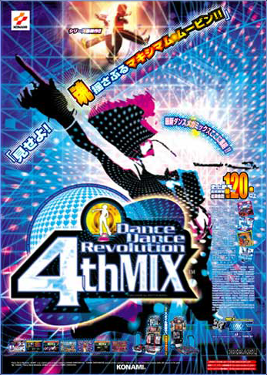
Dance Dance Revolution 4thMix is the fourth game in the main Dance Dance Revolution series of music video games. It was released as an arcade game by Konami on August 24, 2000, in Japan. 4thMix features 136 songs, of which 37 are new songs available and 12 are new unlockables that require an operator code. Dance Dance Revolution 4thMix Plus is an update that unlocks these 12 songs without an operator code, while also adding 14 new songs of its own, for a total of 150 songs.
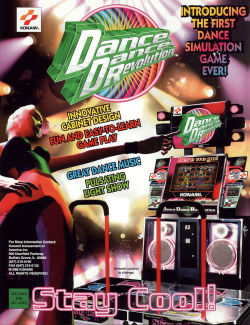
Dance Dance Revolution (DDR) is a music video game, developed by Konami, released in arcades on November 18, 1998, in Japan. Dance Dance Revolution is a unique game involving dance and rhythm that defined the genre. It involves timing and balance by having players use their feet instead of their hands like typical video games. In March 1999, the game was released for North American arcades, and for European arcades under the name Dancing Stage. Players and game critics were caught off-guard by the game's addictive qualities winning the new franchise many merits to its design.

Kid Kool and the Quest for the Seven Wonder Herbs is a 1988 video game by Vic Tokai for the Nintendo Entertainment System. The game's main character is based on a popular Japanese child actor from the 1980s known for his impersonation of baseball player Masayuki Kakefu.
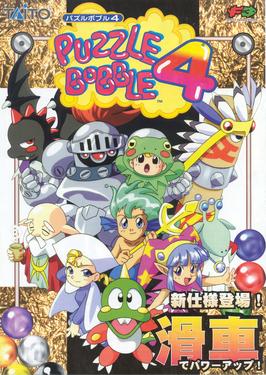
Puzzle Bobble 4 is the third sequel to the video game Puzzle Bobble and is the final appearance of the series on the PlayStation and the only appearance of the series on the Dreamcast.

Rhythm Tengoku is a rhythm game developed and published by Nintendo for the Game Boy Advance. It was originally released on August 3, 2006, and was the last game released by Nintendo for the Game Boy Advance. An arcade version of the game was reprogrammed and published by Sega on September 20, 2007. Both versions were released in Japan exclusively. The game was the first in the Rhythm Heaven series which spawned three international sequels; Rhythm Heaven, Rhythm Heaven Fever, and Rhythm Heaven Megamix. It began as an idea created by its composer and supervisor Tsunku, who proposed it to Nintendo due to his belief that they could do a better job with it than he could.

Dance Dance Revolution Hottest Party, known as Dancing Stage Hottest Party in the European and Oceanic regions, is a video game released by Konami in 2007 and 2008 to several countries for the Wii console. Konami took the game beyond the traditional setup of Dance Dance Revolution by incorporating the Wii Remote and the standard dance pad into a full body motion game. It has two sequels, Dance Dance Revolution Hottest Party 2 and Dance Dance Revolution Hottest Party 3.

Dissidia Final Fantasy is a fighting game with action role-playing elements developed and published by Square Enix for the PlayStation Portable as part of the campaign for the Final Fantasy series' 20th anniversary. It was released in Japan on December 18, 2008, in North America on August 25, 2009, and in Australia and Europe in September. It was then re-released in Japan, based on the North American version, as Dissidia Final Fantasy: Universal Tuning, on November 1, 2009.
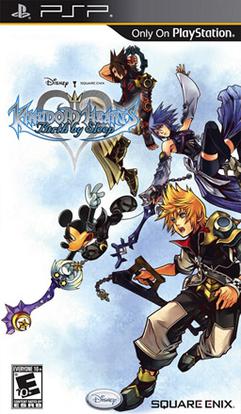
Kingdom Hearts Birth by Sleep is an action role-playing video game developed and published by Square Enix in collaboration with Disney Interactive Studios for the PlayStation Portable, serving as the sixth installment in the Kingdom Hearts series. The game was released on UMD in Japan on January 9, 2010, in North America on September 7, 2010, and in PAL regions on September 10, 2010. An international version of the game titled Kingdom Hearts Birth by Sleep Final Mix was released in Japan in January 2011, featuring the changes made in the non-Japanese versions. A direct sequel, Kingdom Hearts 0.2: Birth by Sleep - A Fragmentary Passage, was released in January 2017 as a part of a bundle of games called Kingdom Hearts HD 2.8 Final Chapter Prologue.

Dance Dance Revolution Extreme is a music video game by Konami and is the eighth release in the main Dance Dance Revolution (DDR) series. It was released on December 25, 2002, for Japanese arcades, on October 9, 2003, for the Japanese PlayStation 2, and on September 21, 2004, for the North American PlayStation 2. This game is the ninth release in North America, but despite having the same name as its Japanese counterpart, its gameplay and soundtrack is significantly different and won the Video Music Awards in 2005 on MTV for Best Video Game Soundtrack.
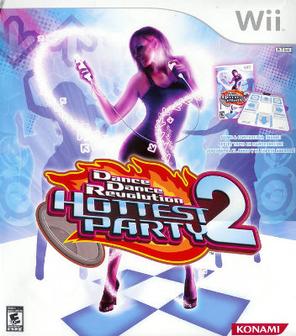
Dance Dance Revolution Hottest Party 2, later released as Dance Dance Revolution Furu Furu Party in Japan, was announced by Konami on May 15, 2008 as part of the 10th anniversary of Dance Dance Revolution celebration. Hottest Party 2 features the same gameplay as the first Hottest Party and introduces new gameplay modes, gimmicks, characters and graphical enhancements. The game also features an all-new soundtrack featuring licensed music from the past four decades as well as new Konami Originals. Hottest Party 2 was released on September 16, 2008 in North America. A teaser site for the Japanese release was launched on December 9, 2008 featuring new gameplay footage from the game.

"Bust a Move" is a song by British-American rapper Young MC from his 1989 debut album, Stone Cold Rhymin'. The song is built on a sample of "Found a Child" by the group Ballin' Jack. The drums, produced by a LinnDrum, are sampled from the song "Radio-Activity" by RoyalCash. The breakdown segment contains a combination of beats sampled from the songs "Scorpio" by Dennis Coffey and the Detroit Guitar Band, and "Daytime Hustler" by Bette Midler. "Bust a Move" also featured guest vocals by Crystal Blake and bass guitar by Red Hot Chili Peppers bassist Flea, who both appear in the music video.

Rhythm Heaven Fever, known in the PAL regions as Beat the Beat: Rhythm Paradise, Minna no Rhythm Tengoku in Japan and Rhythm World Wii in Korea, is a music video game developed by Nintendo and TNX for Nintendo's Wii. It is the third game in the Rhythm Heaven series, following Rhythm Tengoku for the Game Boy Advance and Rhythm Heaven for the Nintendo DS, and was succeeded by Rhythm Heaven Megamix for the Nintendo 3DS in 2016. The game was released in Japan on July 21, 2011, in North America on February 13, 2012, in Europe on July 6, 2012, and in Australia on September 13, 2012. It was digitally re-released for the Wii U in Japan on July 27, 2016, in North America on November 10, 2016, and in Europe on November 22, 2016.

Game Tengoku: The Game Paradise! is a 1995 vertical-scrolling shooter arcade game developed and published by Jaleco. The game is a parody of arcade shooters in a vein similar to the Parodius series. It was followed up with a sequel, Gun Bare! Game Tengoku 2.

Rhythm Heaven Megamix, known in Europe and Australia as Rhythm Paradise Megamix, and in Japan as Rhythm Tengoku: The Best Plus and Rhythm World: The Best Plus in Korea, is a rhythm game developed and published by Nintendo for the Nintendo 3DS. It is the fourth game in Nintendo's Rhythm Heaven series and compiles stages from the series' previous entries; Rhythm Tengoku, Rhythm Heaven, and Rhythm Heaven Fever, as well as adding new ones. The game was released in Japan in June 2015 and in North America, Europe, Oceania, and South Korea throughout 2016.


















